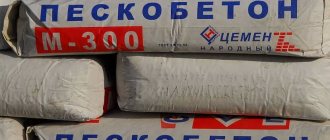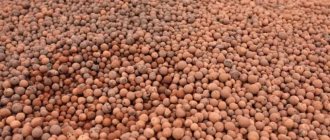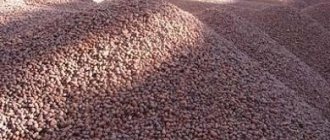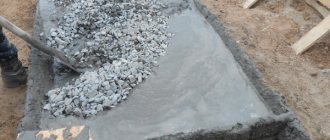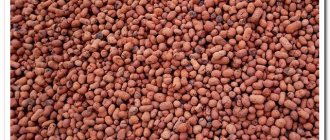Expanded clay is a lightweight porous material of natural origin in the form of granules of various diameters. Material with a cross-section of up to 5 mm is called expanded clay sand; it is used to create compositions with thermal insulation properties. Granules ranging in size from 5 mm to 40 mm - expanded clay gravel - are used as a coarse aggregate for the preparation of lightweight concrete, and also as bulk insulation when forming a floor or roofing pie.
Usually, over the layer of bulk insulation, before laying the finished floor, there is a layer of leveling screed, which is quite problematic to lay on untreated expanded clay. The fact is that this material has great mobility and is not so easy to compact and level. To bind the insulation grains together, prevent them from floating up from under the screed, and simplify the process, cement laitance is used.
The main tasks of pouring expanded clay
Pouring expanded clay with cement laitance helps in solving the following problems:
- the bulk layer is strengthened, increasing its structural impermeability;
- creates the opportunity to obtain reliable filling of free spaces between individual expanded clay granules;
- material spilled with cement laitance receives an additional level of strength and density.
As soon as the cement hardens, the expanded clay layer becomes stable; workers can walk on it, moving light mechanisms without destroying the integrity of the layer. It becomes possible to easily and confidently pour the screed without fear that individual granules will “float up”.
Removal process
There are two methods for removing cement laitance. Each of them has its own advantages and disadvantages, which need to be studied before starting the task.
Methods for removing laitance:
- Mechanical method - using a crushing or sandblasting machine. The technology is complex and financially expensive. But it removes film even in the most inaccessible places. Cleaning can also be done with special metal brushes, but it will have to be done manually for a long time and is tedious.
- Chemical method - using special acid solutions. They quickly remove the film, but have a bad effect on the characteristics of the concrete itself. The method is used when mechanical removal does not give the desired effect. Concentrated alkali is suitable to neutralize the chemical composition, after which the surface is washed well.
Features and rules for preparing cement laitance
The technological process for preparing a cement mortar intended for pouring an expanded clay base looks quite simple. Taking into account the specified working volumes, the calculated amount of cement material is measured. To prepare the required amount of cement laitance per 1 m3, you will need from 260 to 300 kg of M300 cement. It must be remembered that you will need two to three times more water. After everything you need has been prepared, you can begin to prepare the solution:
- the cement material is mixed in a small amount of water, stirred to obtain a homogeneous mass, its consistency reminiscent of sour cream;
- constantly stirring the solution, gradually add water to give the mixture fluidity;
- Some of the cement can be replaced with slaked lime in order to improve the plasticity of the composition and its resistance to moisture.
Additionally, it is recommended to add a primer to the cement laitance. To improve the quality of the solution, the cement should be sifted before pouring with water to prevent the formation of lumps.
How are beacons placed?
The main thing in the process of installing beacons is to mark the base of the floor.
If it is necessary to screed the floor in several adjacent rooms, then it is better to place beacons in all such rooms at once:
They begin to place beacons from the highest point of the surface
- It is important to first determine the top point of the repaired flooring and level the height of the beacons. For this, it is more convenient to use a laser level, since in the case of a water level it is necessary to acquire auxiliary devices (for example, ropes).
- The beacons must be placed from the top point of the base so that the minimum height of the screed in such places reaches 6 mm. In other places of the still uneven surface, the thickness of the fill will be correspondingly greater.
The beacons can be fixed with cement mortar or plaster, but in this case you must act immediately.
Technology of pouring floors with expanded clay
In the construction industry, there are two main options for flooring:
- bulk;
- typesetting
Expanded clay can be used in any of the methods; for this reason, the positive and negative sides must be considered for each case.
Self-leveling floors are installed in houses or low-rise apartments. The installation of rough and finishing screeds reduces the height of the premises by four to five centimeters, and this figure depends on the slope and defective areas present on the floor surface. The monolith seems to minimize vibration, hum, and eliminate the possibility of parasites appearing under the floor. But there is another side to the coin - the monolith is a bridge of cold. To keep the floor warm, it should be equipped with a heating system.
Pouring a floor with expanded clay
Advantages also include:
- efficiency of installation work;
- long operational period;
- wear resistance;
- high resistance to mechanical damage;
- a wide selection of materials for finishing and finishing fills.
Only such floors do not have natural insulation and are characterized by minimal sound insulation.
The typesetting floor option is more complex. First you need to prepare a frame base, into which expanded clay will then be poured or other insulating material will be laid, on top of which the screed will be poured. The process is labor intensive, but the results are completely worth it.
The positive qualities of this gender are:
- high degree of sound insulation;
- natural insulation;
- reduction of financial costs for performing rough screed;
- resistance to temperature changes.
In addition to the listed advantages, there are also negative aspects:
- duration of installation work;
- the height of the frame and the filling layer is about ten centimeters;
- there is a high probability of damage from mechanical impacts.
If we consider the aesthetic side of the issue, the choice of flooring option depends only on the height of the ceiling. From a practical point of view, everyone wants to get a good result. If it is necessary to install heated floors in a private house, it is recommended to choose the option of a stacked design.
Tools and materials
The technology of concrete production and pouring expanded clay with cement laitance implies the presence of the following materials and tools:
- expanded clay, sand, cement material;
- shovels;
- concrete mixers or large containers for making batches;
- rules;
- building level;
- metal profile;
- rammer or roller.
To pour expanded clay you will need a level
Preparing the base
The base of the old concrete floor is cleared of debris and dust. To ensure that the new floor is level, beacons are placed. The easiest way is to use metal profiles. The slats are set from wall to wall in increments equal to the length of the rule. Using a level, the inclined angle is determined. If differences in the floor are noticeable, stones or boards must be placed under the slats. It is much more economical to use nails and cord as beacons. But in this case, you will have to take into account the maximum fluidity of the solution so that the surface is smooth.
Filling is carried out with prepared expanded clay concrete. To do this, combine three shares of sand, one of cement material and one of expanded clay. This solution has a good strength indicator. With an increase in the proportion of expanded clay, the floor becomes warmer, but quickly begins to become covered with cracks and crumble. The exact same situation occurs when sand is manipulated. The solution should be thin enough to fill all voids and uneven areas.
Pouring rough screed
Let's move on to the next working stage. The prepared solution is poured onto the floor into sections arranged with metal slats. After this, the mass is leveled and compacted. To make it convenient to work, you should start from the far walls and gradually move towards the exit. The leveled floor must sit for three days. The rough screed is watered daily to prevent cracks from appearing.
Pouring the finishing screed
This element is necessary when it is planned to use a self-leveling self-leveling floor. Materials, as a rule, are sold in a state prepared for use, and all that remains is to carefully pour the contents of the buckets onto the surface.
Pouring the finishing screed
But if everything is done correctly when installing the rough screed, then the floor will be level enough to lay tiles, parquet or laminate boards on its surface.
Expanded polystyrene concrete
In our practice, we often have to make floor screeds whose thickness exceeds 150 mm. The traditional solution to reduce the weight of such a cake is to install a cement-sand floor screed on a backfill of expanded clay spilled with cement laitance. However, this solution has significant drawbacks. Perhaps the main disadvantage is the fact that the quality and uniformity of the pouring is difficult to control, and filling expanded clay with a thickness of more than 150 mm is extremely difficult to do efficiently.
It is known that any backfill shrinks over time. For example, dry backfill with fine-grained expanded clay or perlite when installing Knauf dry floors shrinks up to 10% of the backfill thickness over a year. That is, if the thickness of the backfill is 50 mm, over time the finishing coating that lies on the backfill will settle by 3-5 mm. Accordingly, the greater the design thickness of the backfill, the more it will shrink.
Thus, if the pouring is performed poorly, there is a risk of uneven shrinkage of individual sections of the backfill and the formation of cracks in these sections of the screed. A reasonable way out of the situation would be to prepare homogeneous expanded clay concrete. Expanded clay gravel is mixed with cement and water using a mortar mixer. If expanded clay has a large fraction (20-40), then it is advisable to add sand. The optimal cement consumption when preparing expanded clay concrete is 200 kg of cement per 1 m3 of expanded clay gravel.
In our practice, we have found a more economical and convenient solution - preparing and laying polystyrene foam D250 as a base for a cement-sand screed.
The composition of the polystyrene foam concrete includes: foam granules fr. 3-5 mm, cement at the rate of 200 kg of cement per 1 m3 of foam granules, foaming agent, salt to accelerate strength gain. The ingredients can be mixed in the hopper of a pneumatic blower and supplied along the hose to the installation site at a height of up to the 20th floor, or mixed in a mortar mixer directly near the installation site. Unlike expanded clay gravel, polystyrene granules are smaller in size and weight and are easily transported. A properly prepared mixture of expanded polystyrene concrete is easily leveled over the base, filling all the unevenness and enveloping communications. A special foaming agent forms a stable dense foam, retains water in the mass of the solution, preventing it from settling down, eliminates the risk of leaks, and ensures uniform strength gain throughout the entire thickness of the layer.
After the initial strength gain, the underlying layer of expanded polystyrene concrete D250 is the optimal base for laying a 60 mm thick cement-sand “semi-dry” floor screed on it.
The thickness of the underlying layer laid in 1 pass can reach up to 700-800 mm. By adding more cement to the solution, you can increase the grade of the mixture and, accordingly, increase the load-bearing load of the cake.
Additional advantages of constructing a two-layer cake with expanded polystyrene concrete D250 are its lower specific gravity compared to expanded clay concrete and high heat and sound insulation characteristics.
Also, the use of expanded polystyrene concrete is very effective for forming slopes on flat roofs, but that’s another story.
Construction of a stacked floor with expanded clay
Under bulk insulation, it is necessary to properly prepare the base, arrange hydro- and vapor barriers using special film materials. It is not recommended to use roofing felt because it does not allow steam to pass through well; moisture appears in the expanded clay bedding, which accelerates the wear and tear of the material and reduces its thermal insulation capabilities.
A frame base made of timber 50 by 50 or 50 by 100 mm is arranged over the insulating layer. The beams are laid in one meter increments to create even squares.
Expanded clay is poured into the prepared boxes and poured with cement laitance using known technology. There should be about one centimeter of free space left from the top edge of the backfill to the surface of the timber. Mesh for reinforcement or reinforcing bars is placed here. After preparing the reinforcing frame, the screed is poured.
To prevent expanded clay from being destroyed by mechanical stress, in addition to pouring it with cement laitance, you can sprinkle the insulation with sand. This will not have an effect on thermal conductivity, and the percentage of friction of stones against each other will significantly reduce.
Expanded clay is considered an environmentally friendly material, lightweight and practical, has a sufficient level of strength, protects against extraneous noise and helps retain heat. Expanded clay screed resists temperature changes and can be used in premises of any purpose.
Application area
Before preparing cement laitance, you need to clearly determine the type and volume of work, and then, depending on the specifics of the application, prepare a mixture with the desired composition.
Where is cement laitance used:
- Repairing minor chips/cracks in the concrete base
- Strengthening the covering layers during the process of pouring the base of the building
- Elimination of various types of damage and defects that appeared in the old concrete monolith
- Treatment of some metal containers to improve anti-corrosion characteristics
- Leveling surfaces
- If you need to pour a layer of expanded clay to give the coating improved thermal insulation properties
- Fastening special bedding for the construction of timber coverings
- Reducing porosity of a variety of surfaces and materials
- Application as a process fluid in the operation of concrete pumps, etc.
Mortar for bricklaying: composition and proportions
During the construction of a building, a variety of masonry mortars are used, because everything here depends on the number of storeys of the building, the mobility of the soil and the type of structure that is being erected. Let's find out which brick laying mortar is applicable in this or that case.
First, let's look at the types of mortars for laying bricks. There are only three of them: lime, cement-lime and cement. Mortar
due to low strength, it is rarely used, although to improve the qualities of cement, yes.
Lime-cement mortar
consists of slaked lime, which is diluted with water to the consistency of milk, cement and sand. To prepare such a solution, cement and sand are thoroughly mixed, after which strained lime is added. This simple technique allows you to increase the plasticity of the solution, making it much easier to work with. This solution can be used for almost any type of bricklaying.
Ordinary cement mortar
also very often used in construction. It consists of sand and cement. The amount of sand in the cement mortar depends only on the quality of cement that was purchased. Cement mortar is inferior in mobility to cement-lime mortar, so it is more difficult to work with.
Now let's look at the brands of solutions. which are used in construction
The brand is very important to know, since the proportions of the mortar for bricklaying directly depend on it
M50 brand solution
usually used to seal cracks and seams indoors during renovations.
M75
is used for partitions and walls indoors.
For external masonry, this mortar is used only in the construction of temporary structures.
Solution brand M100
used to fill the seams of panels, floor screeds, and masonry (solid and large bricks). It is allowed to use mortar for laying the underground part of a brick foundation.
Solution brand M150
used for filling joints in structures made of heavy concrete and screed. This solution has very high strength, therefore, in it, as well as in higher grades, it is unacceptable to use components that provide greater elasticity (lime, gypsum, clay).
M250 mortar is almost never used for masonry work.
. since it is used mainly for the manufacture of especially strong screeds and for the installation of monolithic unloaded floors.
Now let's figure out the proportions of the components for the solution
. Typically, the following ratio is used to prepare the solution: from 1:3 to 1:6 (cement-sand). The amount of sand depends on the quality of the cement. The higher the quality of the cement, the more sand will be required to prepare the solution.
For preparing M100
. As one of the most popular mortars for brickwork, a simple ratio of 1:4 (if cement is M400) or 1:5 (cement M500) is used. To make the solution more elastic, you can add lime to it, in this case the proportions for M100 will be as follows: 1: 3: 0.2 (M400 cement, sand, lime) or 1: 4: 0.3 (M500 cement, sand , lime).
When preparing a good solution, you should take the optimal amount of water
. For ordinary cement mortar, the optimal amount is 0.8 parts of water to 1 part of cement. To prepare the mixture, use only cold and clean water!
The quality of the solution largely depends on the sand. It must be clean, without any stones. For masonry mortars use construction sand with a grain size of 2 to 2.5 mm
. Before preparing the solution, the sand must be sifted, because this way it will mix with the cement much better.
Never prepare too much solution
. after all, after 30 minutes it becomes unusable. Also keep in mind that the prepared solution should be stirred from time to time. When heavy particles settle to the bottom, the solution becomes heterogeneous and stratifies. You cannot make masonry with this solution.
The process of stabilizing the expanded clay layer
The need to fill expanded clay with cement laitance is due to the properties of the material and the need to eliminate some negative factors.
What does pouring expanded clay with laitance give:
- Improving the structural impermeability of the layer, strengthening it
- Guarantee of reliable filling of free spaces between granules
- Increasing the level of density and strength of expanded clay after the milk has dried
After the expanded clay has been poured with cement laitance, the layer becomes more stable, its integrity is not destroyed by the movement of people or light tools and mechanisms. You can perform screed pouring work faster and more efficiently, without the risk of granules floating up.
The milk is prepared in parts so that it can be used without any residue. The layer of expanded clay is shed gradually, as the mass is completely saturated with the solution. After a day, you can begin further work.
Cement laitance is a substance that can act both as a solution that destroys the screed and as a strengthening layer of expanded clay insulation, eliminating deformations and cracks. Depending on what and where the milk is used for, it is prepared according to different recipes (or quickly removed from the surface of the cement screed).






